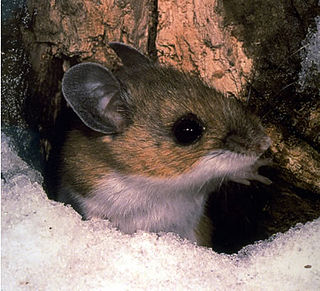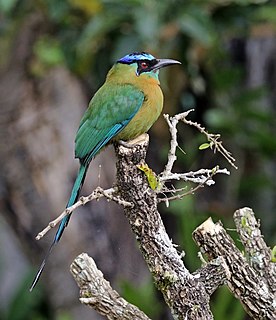
Felidae is a family of mammals in the order Carnivora, colloquially referred to as cats, and constitutes a clade. A member of this family is also called a felid. The term "cat" refers both to felids in general and specifically to the domestic cat.

The Neotominae are a subfamily of the family Cricetidae. They consist of four tribes, 16 genera, and many species of New World rats and mice, predominantly found in North America. Among them are the well-known deer mice, white-footed mice, packrats, and grasshopper mice.
Neacomys pictus, also known as the painted neacomys or painted bristly mouse, is a species of rodent in the genus Neacomys of family Cricetidae. It is found only in Panama.
Nelsonia is a genus of rodent in the family Cricetidae, found in Mexico. It contains the following species:
The diminutive woodrat is a species of rodent in the family Cricetidae. It is endemic to Mexico.
Goldman's woodrat is a rodent species in the family Cricetidae. It is found only in Mexico throughout the Mexican Plateau, stretching from Southeast Chihuahua to South San Luis Potosi and North Queretaro. The plateau is an average 5,988 ft. above sea level and covers a land area of 232,388 sq. miles.
The russet-crowned quail-dove is a species of bird in the family Columbidae. It is found in Panama and far northwestern Colombia. Its natural habitat is subtropical or tropical moist montane forests. It is threatened by habitat loss.
Goldman's pocket mouse is a species of rodent in the family Heteromyidae. It is endemic to Mexico, where it is threatened by the increasing conversion of its dry, scrubby habitat into agricultural land. As a result, the International Union for Conservation of Nature has assessed its conservation status as being "near threatened".

Goldman's broad-clawed shrew is a species of mammal in the family Soricidae. It is found in Guatemala and Mexico.

Pinus nelsonii, Nelson's pinyon, is a species of pine native to the mountains of northeastern Mexico, in Nuevo León, San Luis Potosí and Tamaulipas at 1,800–3,200 m altitude. It has very singular characteristics and is not closely related to any other pines in either morphology or genetics. It is placed in subgenus Strobus either in its own section Nelsonia or subsection Nelsoniae.

Lesson's motmot or the blue-diademed motmot, is a colorful near-passerine bird found in forests and woodlands of southern Mexico to western Panama. This species and the blue-capped motmot, whooping motmot, Trinidad motmot, Amazonian motmot, and Andean motmot were all considered conspecific.

The Guatemalan broad-clawed shrew is a species of small-eared shrew in the family Soricidae. It is known from Guatemala and the Mexican state of Chiapas, where it has been found in montane forests of oak, pine and fir, as well as secondary forest, at elevations above 2,100 m (6,900 ft). It feeds on insects. Deforestation and habitat fragmentation are major threats, particularly in Chiapas. It was formerly considered conspecific with C. goldmani.
Goldman's pocket gopher, is a species of rodent in the pocket gopher family. It is distributed throughout northern Mexico.

Sceloporus scalaris, the bunch grass lizard, is a species of small, phrynosomatid lizard.







